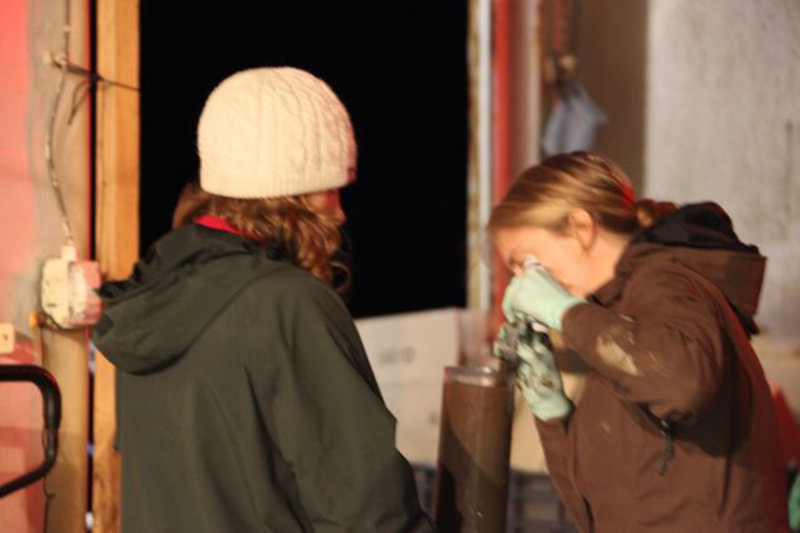
By Alexis Pasulka, Scripps Institution of Oceanography
March 8, 2010
Multicore video footage from the seafloor of Swimming Sea Cucumbers! Video courtesy of INSPIRE: Chile Margin 2010. Download (mp4, 2.6 MB).
Today began a new part of our adventure. We arrived at the Concepcion methane seep area (CMSA) this morning and immediately prepared for sampling with the video-guided multicore. CMSA was first discovered by Javier Sellanes, one of the Chilean professors on board the R/V Melville for this expedition. Although he has sampled this area during three different cruises, Sellanes and his colleagues have never taken images of the area. Therefore, as the multicore approached the seafloor, all of the scientists sat around anxiously awaiting the first glance of what lies on the bottom.

Scientists and research technicians are glued to the multicore video monitors. Ben Grupe points out a sea cucumber. Image courtesy of INSPIRE: Chile Margin 2010. Download image (jpg, 90 KB).
As the multicore moved up and down near the bottom, we encountered more and more deep-sea cucumbers. After maybe an hour or so of watching sea cucumbers fly by our video monitor, we named the area Ensalada Pepino. Ensalada is the Spanish word for salad, and pepino means cucumber, so the name seemed fitting. Maybe it’s because it is the second week of the cruise and we’re all a bit slap happy, maybe it’s because we’re all so excited to come across a methane seep area, or maybe it’s just because we’re an incredibly spirited group of goofy scientists, but we managed to entertain ourselves this morning by making up songs about pepinos while we explored the sea floor.
Not that the images of the sea floor weren’t enough to keep us entertained, but I think there comes a point on every cruise where the scientists get a bit goofy and let loose. This morning’s multicore was that moment (although I’m sure there will be many more). Rosa Leon grabbed her guitar and we all came up with lyrics for our song. Laughter filled the main lab as we moved along the seafloor encountering more and more pepinos. It was a fantastic start to the day. Brian, one of our res-techs, even added his own verse to our song!

Alexis Pasulka and Christina Tanner take water samples from a sediment core. Image courtesy of INSPIRE: Chile Margin 2010. Download image (jpg, 60 KB).
Our search continued through lunch and into the afternoon. We were still looking for indications on the seafloor of the presence of methane. Finally, approaching the scarp, we encountered signs indicating we were in a methane seep area. We ended our search with a successful core in what we believed to be methane seep sediments. Although I won’t give away all of our findings, I can tell you this core at least had signs of the presence of sulfide. Not only did I taste it when trying to siphon off the water from the core (yummy), but I smelled it when slicing the core. Success!
As the day progressed, we conducted several more multicores. We saw lots of stuff on the bottom; but, unfortunately, it seems that the bottom was too hard and we weren't able to collect any good cores. We are now in the processes of a CTD Po-go. This type of CTD sampling allows us to scan the area for signs of methane in the water column. We will use the results of this CTD cast to help plan our sampling scheme in the area.
Things are quiet now in the main lab. The scientists are working away on samples from earlier today, typing at their computers, or watching the CTD monitor. Science never stops on this ship, so I have no doubt that more exciting science will take place in the next few days as we continue to explore the CMSA.